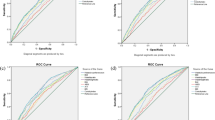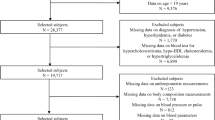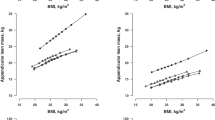Abstract
OBJECTIVE: To examine the relation between adiposity and risk factors for cardiovascular disease (CVD) in normal weight (NW) individuals.
METHODS: Cross-sectional study using the sample of white people, aged from 17 to 60 y from the Québec Family Study and the Heritage Family Study. NW subjects with a body mass index (BMI) between 18.5 and 25 kg/m2 (181 males and 265 females) and overweight (OW) subjects with a BMI between 25 and 30 kg/m2 (133 males and 114 females) were retained for this study. NW subjects were divided into quintiles of each adiposity variable, then the quintiles and the OW group were evaluated for the presence of CVD risk factors. Using logistic regression analysis, the odds ratio (OR) for the prevalence of risk factors for each quintile of each adiposity variable and the OW group was estimated relative to the first quintile in NW subjects. Mean values of adiposity variables were compared between the subjects with and without risk factors. In these analyses, age and study cohort effects were taken into account.
MEASUREMENTS: Percentage body fat (%fat) and fat mass (FM) measured by underwater weighing were available as adiposity variables. Risk factors included systolic and diastolic blood pressure, LDL and HDL cholesterol, triglycerides and fasting glucose.
RESULTS: Wide ranges of values were observed for adiposity variables. HDL cholesterol, triglycerides and fasting glucose in NW males and HDL cholesterol in NW females were significantly correlated with all adiposity variables. For males, higher quintiles of adiposity variables in the NW group and the OW group tended to have higher ORs compared to the first quintiles for the risk factor variables. The fifth quintiles of all adiposity variables had the highest ORs (3.15 for %fat and 3.77 for FM) and they were significantly different from the first quintiles. OW males had ORs similar to those of the fifth quintiles for the risk factor variables. On the other hand, for females, the relatively linear associations were less clear in the NW group. In NW males, the subjects with at least one risk factor had significantly higher %fat and FM than the subjects without risk factors. In NW females, no significant difference was observed for these adiposity variables between the subjects with and without risk factors.
CONCLUSION: NW males with elevated adiposity had higher prevalence of risk factors than NW males with less adiposity and the prevalence in the former was rather similar to that seen in OW males. On the other hand, measures of adiposity added little additional information to the BMI classification of NW on CVD risk factors in females.
This is a preview of subscription content, access via your institution
Access options
Subscribe to this journal
Receive 12 print issues and online access
$259.00 per year
only $21.58 per issue
Buy this article
- Purchase on Springer Link
- Instant access to full article PDF
Prices may be subject to local taxes which are calculated during checkout
Similar content being viewed by others
References
World Health Organization . Obesity: preventing and managing the global epidemic. Report of a WHO consultation on Obesity, Geneva, 3–5, June 1997. World Health Organization: Geneva 1998.
National Institutes of Health and National Heart, Lung, and Blood Institute . Clinical guidelines on the identification, evaluation, and treatment of overweight and obesity in adults. The Evidence Report Obes Res 1998 6(Suppl 2): 51S–209S.
Garrow JS . Indices of adiposity Nutr Abstr Rev 1983 53: 697–708.
Bray GA . Complications of obesity Ann Intern Med 1985 103: 1052–1062.
Manson JE, Stampfer MJ, Hennekens CH, Willett WC . Body weight and longevity. A reassessment JAMA 1987 257: 353–358.
Troiano RP, Frongillo EA Jr, Sobal J, Levitsky DA . The relationship between body weight and mortality: a quantitative analysis of combined information from existing studies Int J Obes Relat Metab Disord 1996 20: 63–75.
Keys A, Fidanza F, Karvonen MJ, Kimura N, Taylor HL . Indices of relative weight and obesity J Chron Dis 1972 25: 329–343.
National Institutes of Health Consensus Development Panel on the Health Implications of Obesity . Health Implications of obesity. National Institutes of Health consensus development conference statement Ann Intern Med 1985 103: 1073–1077.
Garn SM, Leonard WR, Hawthorne VM . Three limitations of the body mass index Am J Clin Nutr 1986 44: 996–997.
Smalley KJ, Knerr AN, Kendrick ZV, Colliver JA, Owen OE . Reassessment of body mass indices Am J Clin Nutr 1990 52: 405–408.
Hannan WJ, Wrate RM, Cowen SJ, Freeman CPL . Body mass index as an estimate of body fat Int J Eating Disorders 1995 18: 91–97.
Baumgartner RN, Heymsfield SB, Roche AF . Human body composition and the epidemiology of chronic disease Obes Res 1995 3: 73–95.
Hortobagyi T, Israel RG, O'Brien KF . Sensitivity and specificity of the Quetelet index to assess obesity in men and women Eur J Clin Nutr 1994 48: 369–375.
Wellens RI, Roche AF, Khamis HJ, Jackson AS, Pollock ML, Siervogel RM . Relationships between the body mass index and body composition Obes Res 1996 4: 35–44.
Ruderman NB, Schneider SH, Berchtold P . The ‘metabolically-obese’, normal-weight individual Am J Clin Nutr 1981 34: 1617–1621.
Ruderman N, Chisholm D, Pi-Sunyer X, Schneider S . The metabolically obese, normal-weight individual revisited Diabetes 1998 47: 699–713.
Heber C, Ingles S, Ashley JM, Maxwell MH, Lyons RF, Elashoff RM . Clinical detection of sarcopenic obesity by bioelectrical impedance analysis Am J Clin Nutr 1996 64: 472S–477S.
Dvorak RV, DeNino WF, Ades PA, Poehlman ET . Phenotypic characteristics associated with insulin resistance in metabolically obese but normal-weight young women Diabetes 1999 48: 2210–2214.
Bouchard C . Genetic epidemiology, association, and sib-pair linkage: results from the Québec Family Study. In: Bray GA, Ryan DH (eds). Molecular and genetic aspects of obesity. Pennington Center Nutrition Series 5: Louisiana State University Press: Baton Rouge, LA 1996 470–481.
Bouchard C, Leon AS, Rao DC, Skinner JS, Wilmore JH, Gagnon J . The HERITAGE Family Study. Aims, design, and measurement protocol Med Sci Sports Exerc 1995 27: 721–729.
Gagnon J, Province MA, Bouchard C, Leon AS, Skinner JS, Wilmore JH, Rao DC . The HERITAGE Family Study: quality assurance and quality control Ann Epidemiol 1996 6: 520–529.
Weiner J, Lourie J . Human biology: a guide to field methods. Blackwell: Oxford 1969.
Lohman TG, Roche AF, Martorell R (eds) . Anthropometric standardization reference manual. Human Kinetics: Champaign; IL 1988.
Wilmore JH, Stanforth PR, Domenick MA, Gagnon J, Daw EW, Leon AS, Rao DC, Skinner JS, Bouchard C . Reproducibility of anthropometric and body composition measurements: the HERITAGE Family Study Int J Obes Relat Metab Disord 1997 21: 297–303.
Behnke AR, Wilmore JH . Evaluation and regulation of body build and composition. Prentice Hall: Englewood Cliffs, NJ 1974.
Meneely GR, Kaltrieder NL . The volume of the lung determined by helium dilution. Description of the method and comparison with other procedures J Clin Invest 1949 20: 129–139.
Motley HL . Comparison of a simple helium closed with the oxygen open-circuit method for measuring residual air Am Rev Turberc Pulm Dis 1957 76: 601–615.
Wilmore JH . A simplified method for determination of residual lung volume J Appl Physiol 1969 27: 96–100.
Wilmore JH, Vodak PA, Parr RB, Girandola RN, Billing JE . Further simplification of a method for determination of residual lung volume Med Sci Sports Exerc 1980 12: 216–218.
Siri WE . The gross composition of the body. In: Lawrence JH, Tobias CA (eds) Advances in biological and medical physics IV: Academic Press: New York 1956 239–280.
Lohman TG . Applicability of body composition techniques and constants for children and youths Exerc Sport Sci Rev 1986 14: 325–357.
Fuller NJ, Jebb SA, Laskey MA, Coward WA, Elia M . Four-component model for the assessment of body composition in humans: comparison with alternative methods, and evaluation of the density and hydration of fat-free mass Clin Sci 1992 82: 687–693.
Wang ZM, Deurenberg P, Guo SS, Pietrobelli A, Wang J, Pierson RN Jr, Heymsfield SB . Six-compartment body composition model: inter-method comparisons of total body measurement Int J Obes Relat Metab Disord 1998 22: 329–337.
Havel RJ, Eder H, Bragdon HF . The distribution and chemical composition of ultracentrifugally separated lipoproteins in human serum J Clin Invest 1955 34: 1345–1353.
Burstein M, Samaille J . Sur un dosage rapide du cholestérol lié aux B-lipoprotéines du sérum Clin Chim Acta 1960 5: 609–610.
Richterich R, Dauwalder H . Zur bestimmung der plasmaglukosekonzentration mit der hexokinase-glucose-6-phosphat-dehydrogenase-methode Schweiz Med Wochenschr 1971 101: 615–618.
Rankinen T, Pérusse L, Dériaz O, Thériault G, Chagnon M, Nadeau A, Bouchard C . Linkage of the Na, K-ATPase α2 and β1 genes with resting and exercise heart rate and blood pressure: cross-sectional and longitudinal observations from Quebec Family Study J Hypertens 1999 17: 339–349.
Rankinen T, Gagnon J, Pérusse L, Rice T, Leon AS, Skinner JS, Wilmore JH, Rao DC, Bouchard C . Body fat, resting and exercise blood pressure and the angiotensinogen M235T polymorphism: the HERITAGE family study Obes Res 1999 7: 423–430.
American Heart Association Science Advisory . Guide to primary prevention of cardiovascular diseases. A statement for healthcare professionals from the Task Force on Risk Reduction Circulation 1997 95: 2329–2331.
The Joint National Committee on Prevention, Detection, Evaluation and Treatment of High Blood Pressure . The sixth report of the Joint National Committee on Prevention, Detection, Evaluation and Treatment of High Blood Pressure Arch Intern Med 1997 157: 2413–2446.
The Expert Committee on the Diagnosis and Classification of Diabetes Mellitus . Report of the Expert Committee on the Diagnosis and Classification of Diabetes Mellitus Diabetes Care 1998 21: S5–S19.
Knopp RH, Zhu X, Bonet B . Effects of estrogen on lipoprotein metabolism and cardiovascular disease in women Atherosclerosis 1994 110: S83–S91.
Bush TL . Evidence for primary and secondary prevention of coronary artery disease in women taking estrogen replacement therapy Eur J Heart J 1996 17: 9–14.
Mendelsohn ME, Karas RH . The protective effect of estrogen on the cardiovascular system New Engl J Med 1999 340: 1801–1811.
Després JP, Ferland M, Moorjani S, Nadeau A, Tremblay A, Lupien PJ, Thériault G, Bouchard C . Role of hepatic-triglyceride lipase activity in the association between intra-abdominal fat and plasma HDL cholesterol in obese women Arteriosclerosis 1989 9: 485–492.
Terry RB, Stefanick ML, Haskell WL, Wood PD . Contributions of regional adipose tissue depots to plasma lipoprotein concentrations in overweight men and women: possible protective effects of thigh fat Metabolism 1991 40: 733–740.
Abe T, Fukunaga T . Relationships between subcutaneous fat and muscle distributions and serum HDL-cholesterol J Atheroscler Thromb 1994 1: 15–22.
Freedman DS, Rimm AA . The relation of body fat distribution, as assessed by sex girth measurements, to diabetes mellitus in women Am J Publ Health 1989 79: 715–720.
Sjöström L, Kvist H . Regional body fat measurements with CT-scan and evaluation of anthropometric predictions Acta Med Scand 1988 723(Suppl): 169–177.
Baumgartner RN . Electrical impedance and total body electrical conductivity. In: Roche AF, Heymsfield SB, Lohman TG (eds). Human body composition. Human Kinetics: Champaign, IL 1996 79–107.
Reaven GM, Lithell H, Landsberg L . Hypertension and associated metabolic abnormalities: the role of insulin resistance and the sympathoadrenal system New Engl J Med 1996 334: 374–381.
Caro JF . Insulin resistance in obese and non-obese men J Clin Endocrinol Metab 1991 73: 691–695.
Wajchenberg B, Leo M, Domingos A, Rocha MS, Lerario AC, Santomauro A, Tereza MG . Syndrome X: a syndrome of insulin resistance: epidemiological and clinical evidence Diabetes Metab Rev 1994 10: 19–29.
Hueneman RL, Hampton MC, Shapiro LR, Behnke AR . Adolescent food practices associated with obesity Fed Proc 1966 25: 4–10.
McArdle WD, Katch FI, Katch VL . Exercise physiology: energy, nutrition and human performance, 3 edn. Lea & Febiger: Malvern, PA 1991 659–660.
Ko GTC, Chan JCN, Cockram CS, Woo J . Prediction of hypertension, diabetes, dyslipidaemia or albuminuria using simple anthropometric indexes in Hong Kong Chinese Int J Obes Relat Metab Disord 1999 23: 1136–1142.
Regional Office for the Western Pacific of the World Health Organization, the International Association for the Study of Obesity and the International Obesity Task Force . The Asia-Pacific perspective: redefining obesity and its treatment. Health Communications Australia Pty Ltd: Melbourne 2000.
Fujimoto WY, Bergstrom RW, Boyko EJ, Leonetti DL, Newell-Morris LL, Wahl PW . Susceptibility to development of central adiposity among populations Obes Res 1995 3: 179s–186s.
Deurenberg P, Yap M, van Staveren WA . Body mass index and percent body fat: a meta analysis among different ethnic groups Int J Obes Relat Metab Disord 1998 22: 1164–1170.
Acknowledgements
This work was supported in part by the Medical Research Council of Canada (PG-11811 and MT-13960) and the National Heart, Lung and Blood Institute (HL45670 (C Bouchard, PI), HL47323 (AS Leon), HL47317 (DC Rao), HL47327 (JS Skinner), and HL47321 (JH Wilmore)). Thanks are expressed to all research assistants, technicians and secretaries who have been involved in the data collection and laboratory work. The authors would like to acknowledge the contributions of Drs J Bergeron, JP Després and A Nadeau, and their staff, of the Laval University Medical Center (CHUL) for the lipid and glucose assays, Dr J Volaufova for her advice on the statistical method, and N Laidlaw for her assistance in the preparation of this manuscript. C Bouchard is partially funded by the George A Bray Chair in Nutrition.
Author information
Authors and Affiliations
Corresponding author
Rights and permissions
About this article
Cite this article
Tanaka, S., Togashi, K., Rankinen, T. et al. Is adiposity at normal body weight relevant for cardiovascular disease risk?. Int J Obes 26, 176–183 (2002). https://doi.org/10.1038/sj.ijo.0801880
Received:
Revised:
Accepted:
Published:
Issue Date:
DOI: https://doi.org/10.1038/sj.ijo.0801880
Keywords
This article is cited by
-
Characterization of Cardiometabolic Risks in Different Combination of Anthropometric Parameters and Percentage Body Fat
Scientific Reports (2019)
-
Role of Obesity Variables in Detecting Hypertension in an Iranian Population
High Blood Pressure & Cardiovascular Prevention (2017)
-
Prevalence of incorrect body posture in children and adolescents with overweight and obesity
European Journal of Pediatrics (2017)
-
Body composition and physical activity in Italian university students
Journal of Translational Medicine (2014)
-
To treat or not to treat: comparison of different criteria used to determine whether weight loss is to be recommended
Nutrition Journal (2008)



